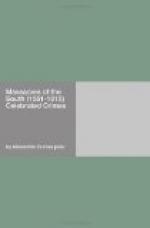On reaching his destination, the young missionary had found himself surrounded by circumstances which were wonderfully in harmony with his celestial longings: some of his predecessors had been carried so far by religious zeal that the King of Siam had put several to death by torture and had forbidden any more missionaries to enter his dominions; but this, as we can easily imagine, only excited still more the abbe’s missionary fervour; evading the watchfulness of the military, and regardless of the terrible penalties imposed by the king, he crossed the frontier, and began to preach the Catholic religion to the heathen, many of whom were converted.
One day he was surprised by a party of soldiers in a little village in which he had been living for three months, and in which nearly all the inhabitants had abjured their false faith, and was brought before the governor of Bankan, where instead of denying his faith, he nobly defended Christianity and magnified the name of God. He was handed over to the executioners to be subjected to torture, and suffered at their hands with resignation everything that a human body can endure while yet retaining life, till at length his patience exhausted their rage; and seeing him become unconscious, they thought he was dead, and with mutilated hands, his breast furrowed with wounds, his limbs half warn through by heavy fetters, he was suspended by the wrists to a branch of a tree and abandoned. A pariah passing by cut him down and succoured him, and reports of his martyrdom having spread, the French ambassador demanded justice with no uncertain voice, so that the King of Siam, rejoicing that the executioners had stopped short in time, hastened to send back to M. de Chaumont, the representative of Louis XIV, a mutilated though still living man, instead of the corpse which had been demanded.
At the time when Louis XIV was meditating the Revocation of the Edict of Nantes he felt that the services of such a man would be invaluable to him, so about 1632, Abbe Duchayla was recalled from India, and a year later was sent to Mende, with the titles of Arch-priest of the Cevennes and Inspector of Missions.
Soon the abbe, who had been so much persecuted, became a persecutor, showing himself as insensible to the sufferings of others as he had been inflexible under his own. His apprenticeship to torture stood him in such good stead that he became an inventor, and not only did he enrich the torture chamber by importing from India several scientifically constructed machines, hitherto unknown in Europe, but he also designed many others. People told with terror of reeds cut in the form of whistles which the abbe pitilessly forced under the nails of malignants; of iron pincers for tearing out their beards, eyelashes, and eyebrows; of wicks steeped in oil and wound round the fingers of a victim’s hands, and then set on fire so as to form a pair of five-flamed candelabra; of a case turning on a pivot in which a man who refused to be converted was sometimes shut up, the case being then made to revolve rapidly till the victim lost consciousness; and lastly of fetters used when taking prisoners from one town to another, and brought to such perfection, that when they were on the prisoner could neither stand nor sit.




